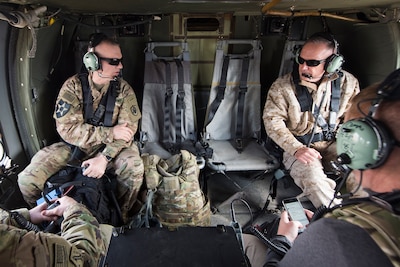By Jim Garamone DoD News, Defense Media Activity
WASHINGTON, April 2, 2018 — Afghan security forces need
maintenance and logistics training to ensure they are ready for the long haul
against the Taliban and other terror groups, the senior enlisted advisor to the
chairman said during a recent Pentagon interview.
Army Command Sgt. Maj. John W. Troxell also spoke about the
advisory mission, Afghan noncommissioned officers and the effect of the Afghan
Inherent Law.
In March, the sergeant major accompanied his boss -- Marine
Corps Gen. Joe Dunford, the chairman of the Joint Chiefs of Staff -- to
Afghanistan for an in-depth look at operations and strategy in the country.
Troxell served in Afghanistan as the senior enlisted advisor
for the International Security Assistance Force’s Joint Command in 2011 and
2012.
“Back then, we had over 100,000 coalition troops,” he said.
“The U.S. and coalition forces were still conducting combat operations side-by-side
with our Afghan partners. It came at a cost on U.S., coalition and Afghan
forces. On the coalition side that year, we lost 332 killed in action and the
Afghans suffered three times that.”
Afghan Forces Now in the Lead
Now the Afghans are in the lead, and, compared to 2012, the
coalition footprint is miniscule -- around 14,000 service members spread
throughout the country.
The initial results of the train, advise and assist efforts
have been successful in the north and east of Afghanistan. And now the Army’s
1st Security Force Assistance Brigade has deployed to the country, which
coalition leaders have said will provide Afghan commanders with more
flexibility and capacity. “I think there is a lot of potential with the security
force assistance brigade,” the sergeant major said. “The Afghans are capable of
combined arms maneuver and incorporating special operations forces.”
The Afghan air force is developing, he said, and Afghan
commanders have shown they know exactly what to do with airpower in many
different situations. The Afghan military is also deriving “synergy across
pillars -- from the military to the police to the national defense service,”
Troxell said.
Until troop levels were raised recenly , coalition service members
could only advise down to the corps level, the sergeant major said. Advisers
provided institutional help aimed at setting up operations and making progress
on rearming and resupplying Afghan units.
Now there is the capability to advise at a much lower level:
brigade, kandak (about the size of a battalion), and even at the toil (or
company) level. “I think as we reduced down to 6,000, we pulled off of some of
these [Afghan] brigades,” Troxell said. “And in some cases those brigades
severely atrophied in terms of readiness, in terms of capabilities, in terms of
capacity and in terms of motivation.”
Some Afghan units fell back on a “checkpoint mentality,” the
sergeant major said. “Although checkpoints show the population that the
security forces are out in force, you are fixing yourself to a piece of terrain
that an enemy can easily exploit,” he said. “We are going to continue to train
the Afghans to be more dynamic on what they do out there, and help them
understand that in order to influence a piece of terrain, you don’t have to be
standing on top of it.”
Aggressive, Unpredictable Patrolling
The best Afghan units use aggressive, unpredictable
patrolling, Troxell said. They use movement to contact to find and fix the
enemy and then call on reinforcements, air or artillery to complete the
mission.
The senior enlisted advisor says that SFAB service members
must remember that their mission is to train, advise and assist. “Only under
special circumstances -- and it has to be command directed -- do they accompany,”
he said.
American service members are trained to fight, but that is
not their primary mission in Afghanistan at the present, Troxell said.
“Obviously, they can respond if attacked, but they are there
to build capacity into the Afghan security forces,” he explained.
The key thing to do is ensure Afghans continue to lead the
fight, he said. “They’ve got to continue to take the fight to the Taliban to
convince them they cannot win a conflict with the Afghan security forces,” the
sergeant major said.
Maintenance, sustainment and logistics at brigade and below
levels need work, Troxell said. “They haven’t had the rigor or discipline that
comes with accomplishing maintenance or logistics,” he said. “It would be easy
to just give them new equipment, but we owe it to the American taxpayer to have
these disciplined supply and logistics procedures that Afghan forces must learn
and work.”
New Afghan Military Leadership
New Afghan leadership should energize this effort, the
sergeant major said. The Inherent Law enacted by the Afghan parliament will
retire with honor many senior officers in the Afghan military. These are
elderly men who grew up under a Soviet model, and they don’t understand there
is a better way to run operations than under the hierarchical model.
The officers have been replaced by younger men who have been
trained to understand mission command and command supply and discipline. “I
think it will be more efficient and effective operations and support,” Troxell
said.
The Afghans are also making a huge investment in their
noncommissioned officer corps. Afghan President Ashraf Ghani has not forgotten
that NCOs saved the 215th Corps in Helmand province when the Marines left, the
sergeant major said. Afghan army Sgt Maj. Roshan Safi has been named as the
senior enlisted advisor to the defense minister, the chief of defense and the
president. He has been fighting since he was 14.
The Afghans have also built a sergeants major academy based
on the U.S. model and they are sending some NCOs to officer academies.
“They will know what it is like to have empowered NCOs, and
the idea is they will encourage that model,” Troxell said. “In the end, those
NCOs have to take and want that responsibility.”








No comments:
Post a Comment